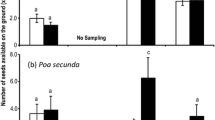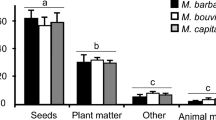Abstract
Two species of harvester ants, Chelaner whitei and C. rothsteini, were studied in the far west of N.S.W. Data collected in both field and laboratory were used to study seed utilization and the effect of seed supply upon harvester ant populations. Nest density, foraging activity and colony reproduction were monitored throughout the study. Four nests of each species were excavated (one in each season) to determine nest structure, colony size and seasonal changes in colony composition. There were 156 colonies of C. whitei and 66 colonies of C. rothsteini on the study plot. Colonies ranged in size from 450 to 40,000 workers (C. whitei); and from 15,000 to 58,000 (C. rothsteini). C. whitei foraged all year round. C. rothsteini ceased foraging during winter. Peak foraging by both species occurred in summer, when both species predominantly gathered seeds of ephemeral grasses and forbs. Differences in seed selection by the two species were related to size, phenology and chemical composition of the seeds and fruit. All seeds taken into the colonies were eventually fed to the larvae. Food digested by the larvae was transmitted through the colony by trophallaxis (from larvae to the workers). The final stage larvae of C. rothsteini were found to act as a storage caste resulting in decreased foraging activity by this species when sufficient larval fat stores had accumulated. It is postulated that seed supply is the most important factor regulating populations of harvester ants. Finally, speculations are advanced concerning possible reciprocal long-term evolutionary effects of the interaction between harvester ants and plants.
Access this chapter
Tax calculation will be finalised at checkout
Purchases are for personal use only
Preview
Unable to display preview. Download preview PDF.
Similar content being viewed by others
References
Carroll, C. R. & Janzen, D. H., 1973. Ecology of foraging by ants.Ann. Rev. Ecol. Syst. 4: 231–257.
Davison, E. A., 1980. Ecological studies of two species of harvester ants, Chelaner whitei and C. rothsteini, in an arid habitat in south eastern Australia (Hymenoptera: Formicidae). Ph. D. Thesis, U.N.E., Armidale.
Janzen, D. H., 1971. Seed prédation by animals. Ann. Rev. Ecol. Syst. 2: 465–492.
Kendeigh, S. C. & West, G. C., 1965. Caloric values of plant seeds eaten by birds. Ecology 46: 553–555.
Levin, D. A., 1974. The oil content of seeds: an ecological perspective. Am. Nat. 108: 193–206.
Southwood, T. R. E., 1966. Ecological Methods with Particular Reference to the Study of Insect Populations. Methuen, London.
Editor information
Editors and Affiliations
Rights and permissions
Copyright information
© 1982 Dr W. Junk Publishers, The Hague
About this chapter
Cite this chapter
Davison, E.A. (1982). Seed utilization by harvester ants. In: Buckley, R.C. (eds) Ant-plant interactions in Australia. Geobotany, vol 4. Springer, Dordrecht. https://doi.org/10.1007/978-94-009-7994-9_1
Download citation
DOI: https://doi.org/10.1007/978-94-009-7994-9_1
Publisher Name: Springer, Dordrecht
Print ISBN: 978-94-009-7996-3
Online ISBN: 978-94-009-7994-9
eBook Packages: Springer Book Archive




